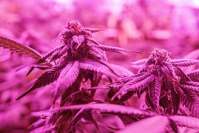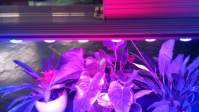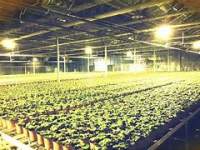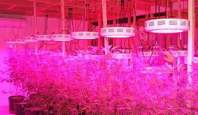Advantages of LED plant lights in plant breeding
The five pillars essential for plant growth are temperature, moisture, nutrition, air and light. As the saying goes, everything depends on the sun to grow, and what should we do if we encounter severe weather such as haze and rainy days? Plant growth lights can help us replace sunlight to give plants an environment for growth and development.
Crops, like people, require exercise, work, and rest. Therefore, when using LED plant lights to fill the plants with light, you must also control the time. It is recommended that the plant's light time be controlled between 12 and 16 hours to allow the plants to stay. Give plenty of time to rest to ensure the efficiency of the plant’s daily work.
The quality of light has a very obvious impact on the growth of plants at various stages. For example, flowering and fruiting plants need sufficient red light during the period of flowering and fruit setting. If the red light is not enough, no matter how great the light is, the desired effect will not be achieved. The flowering and fruit-setting rate of the plant.
If the various lights of the plants can be matched in proportion to supplement the light according to the needs of the plants, the effect will be completely different. It will not only shorten the plant growth cycle, but also increase the yield and quality of the plants. This is also the reason for the emergence of plant lights, and it is the reason why LED plant lights replace traditional plant growth lights.
When the time and light quality are reasonable, it is necessary to use LED plant lights to control the light intensity. If the light intensity is not enough, the photosynthesis and respiration of plants will not even reach the same level, and it is even more impossible to think about plant growth.
If the light intensity is too strong and it exceeds the light saturation point too much, it is purely a waste of electric energy. Therefore, the most ideal value state is to control the light intensity around the light saturation point so that the plants can grow healthily and at the fastest speed.
If there is not enough light to grow flowers, can you still add light to plants? Modern Yaorong Technology has done it, and it can also be applied to different light according to different plants~
Regarding the lack of light, whether it is possible to make up for this problem with LED plant supplement light, the answer is yes! Take the rose plant as an example. We know that the rose requires strong sunlight to grow healthily. If the light is insufficient, it will not grow well. Then the emergence of the supplementary light can indeed make up for the lack of sunlight to a certain extent.
Plants’ need for light is mainly for photosynthesis. We all know that photosynthesis can not only produce oxygen, but also accumulate a large amount of nutrients for plants. These nutrients are inseparable from helping plants grow, absorb nutrients, and reproduce and grow. A strong accumulation of photosynthesis. Normally, ordinary sunlight can meet the photosynthesis of plants. For different plants, the demand for sunlight is different, but no matter what kind of plant, it needs sunlight, this is for sure.
In nature, the light of plants mainly comes from the sun, but when the sun is insufficient, the plants will not grow. At this time, it is necessary to rely on artificial light sources to supplement the light of the plant growth lamps.
Now on the market, LED plant lights can be customized according to the full spectrum of dedicated LED plants to give plants the light of the sun, greatly improve the efficiency of plant photosynthesis, and abandon useless light. According to different growth environments, it provides plants with an ideal light environment for photosynthesis and promotes the growth of plants at different stages.
The cool white light color is suitable for supplementing light for succulents and small flowers, preventing steep growth, beautiful plant shape, maintaining bright colors and prolonging the flowering period. Small flowers such as longevity flower, snapdragon, petunia, pansy, mini rose, Rieger begonia, water lily, etc.
The warm white light color is suitable for indoor foliage plants to make the leaf color healthier, the plant type more compact, and the leaves thicker.
Purple-red light color florescence lamp is suitable for flowers, long-day flowers such as roses, gladiolus, iris, cineraria, impatiens, violets, poppies, lilies, etc.
The principle of plant supplementary light is mainly to imitate the full-spectrum light of the sun. LED lights are generally the most common now. The advantages are low wattage and low power consumption. Households are a very practical way of supplementing light. When buying led plant growth lights, be sure to choose suitable cheap lights. Most of them are inferior and can not achieve the real light supplement effect. Not to mention the power consumption of buying home, it also starts to have a practical effect. It is more worry-free to trust the big brands.
LED plant light is a special LED plant growth lamp with a specific spectral wavelength designed to replace sunlight with light emitted by LED light-emitting elements, specifically to promote plant photosynthesis, and to create a light environment suitable for plant growth and development.
LED plant lights can control the spectral wavelength very well, and can fully meet the needs of plants for light. The spectral wavelength required for plant photosynthesis is usually in the range of 400 ~ 660nm. The blue light of 400 ~ 520nm and the red light of 610 ~ 720nm contribute the most to the photosynthesis of plants. The red and blue wavelengths of LED plant lights are just in this range, which can provide plants with spectral wavelengths suitable for their growth to promote plant growth.
At the same time, LED plant growth lamps are also energy-saving (high photoelectric conversion efficiency, power consumption is 1/4 of fluorescent lamps, 1/10 of sodium lamps), spectral controllability and adjustable, good point light source, luminescence (low heat) , Good moisture resistance, small size, long life (more than 30,000 hours), etc.
Plants "walk" from outdoor to indoor: Studying the growth behavior of plants outdoors not only covers a large area, but also has many uncertain factors, and it is impossible to fully quantify the research parameters of plant cultivation. Indoors are completely different. What kind of problems does each plant need in different growth periods, what kind of temperature, what kind of light, and what kind of light quality can grow best, and under what circumstances What are the different changes? With these quantitative parameters, different plants can be planted in various growth states according to the different needs of human beings. Only LED plant growth lights can make plants "walk" from outdoors to indoors. At present, only LED full-spectrum plant lights can enable indoor research to achieve the highest efficiency.






